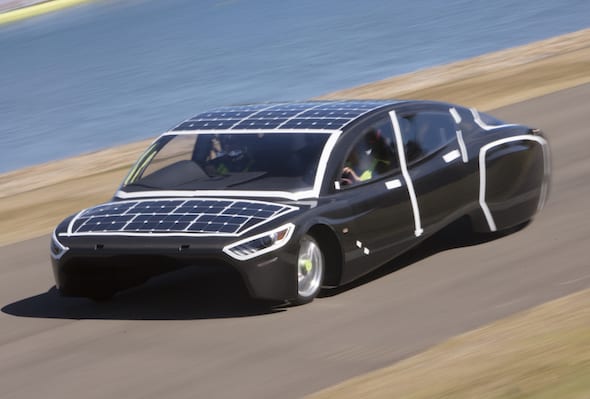Two new Australian made solar cars are making news this week, and helping to drive the once space-aged notion of solar powered electric vehicles into the automotive mainstream.
The first, named Violet, is the latest model of solar car to be built by the UNSW Sunswift team of engineers. It will race across the continent in the upcoming Bridgestone World Solar Challenge, powered only by the sun.
The second, is a two-seater ‘Cruiser Class’ solar sports coupe (pictured above) built by a Brisbane company called Clenergy TeamArrow – and it is in its own race: to be the world’s first commercially available solar-powered car.
The Arrow STF (Sports Touring Framework) was officially launched in Queensland on Thursday, after being designed and built in Brisbane. The sports coupe has a top speed of 150km per hour and can travel 1000km before needing to recharge.
Just testing our MPPT’s ✌????Tonight is also our Launch Event! #getexcited #clenergyteamarrow #teamarrow #BWSC17 #ArrowSTF pic.twitter.com/hWOjziggnb
— Clenergy TeamArrow (@teamarrowracing) September 21, 2017
Queensland’s minister for innovation, Leeanne Enoch, said the car was an example of “Queensland ingenuity at its best” and was a “game changer for the passenger vehicle market with potential to boost the state’s economy through new products, services and jobs.
“More than that, this innovation has the potential to reduce the $4.2 billion spent each year by Queensland households on petrol by as much as 90 per cent in the foreseeable future,” she said.
TeamArrow will also race its prototype vehicle against the UNSW’s Sunswift Violet – and around 50 other contenders – in this year’s Bridgestone World Solar Challenge, a race from Darwin to Adelaide.
“The solar vehicle unveiled today at the testing track is the racing version of the Arrow STF which will shortly leave for the Northern Territory to compete in a 3000km endurance challenge through the Red Centre from Darwin to Adelaide starting 8 October 2017,” said Enoch.
“A customisable version is available to the general public and I understand that orders are already rolling in,” she said.
Clenergy TeamArrow Founder Cameron Tuesley said the car’s energy management system included a highly efficient solar array that generates 1.1 kilowatts total power, making it able to of self-charge from sunlight, as well to charge from the electricity grid.
“The version you’re seeing today features a pared-back, race-configured cockpit suitable for long-range events like the Bridgestone World Solar Challenge,” said Tuesley.
“For individual buyers we will build customised versions which have all the features you would expect in a luxury sports car, including air conditioning and infotainment,” he said.
In New South Wales, the Sunswift team is also making its final preparations to drive its sixth generation solar car, Sunswift Violet, the more than 4,000km to Darwin to compete in the Bridgestone World Solar Challenge.
And while winning the race across the continent is important to the team, its ultimate goal has always been to design and build a car that can meet the requirements for road registration in Australia.
This year, the UNSW team have come a major step closer to meeting that challenge.

“Violet looks like a family sedan, but uses as much power as a four-slice toaster,” says Sunswift team leader Simba Kuestler.
“She’s got entertainment and air conditioning systems, including navigation, reverse camera parking sensors, and there’s even Wi-Fi aboard. And she’s got plenty of front and rear boot space.”
But this doesn’t mean she’s not a contender to win the race. Like her predecessors – including the 2014 model, which smashed a 26-year old electric car world record for speed over 500km, with an average of more than 100km/h – Violet was also built for speed and endurance.
The car has a top speed of 130km/h and a range of 800km running on its rooftop solar panels alone. It also has modular lithium-ion batteries which store the solar power, and which can power the car on their own for a range of 400km.

Of course, what really sets the car apart from most regular family sedans is the 284x SunPower monochrystalline cells covering the vehicle’s chassis, and providing a peak power output of 1.1kW.
Violet relies on around 7kW of horsepower at 110km/h, and two 1.5kW motors that run at 98 per cent efficiency, the UNSW team says. She also weighs in at only 380kg, thanks to a twill carbon-fibre monocoque chassis.
“And because good aerodynamics are vital in the quest for energy efficiency – the more slippery the car, the better – Sunswift Violet has a drag coefficient below 0.2, better than the best wind-cheating cars on the market,” the Sunswift team says.
Teams competing in this year’s Bridgestone World Solar Challenge come from Belgium, Canada, Chile, Germany, Hong Kong, India, Iran, Japan, Malaysia, the Netherlands, Poland, Singapore, South Africa, South Korea, Sweden, Taiwan, Thailand, Turkey, the United Kingdom and the United States as well as Australia.








